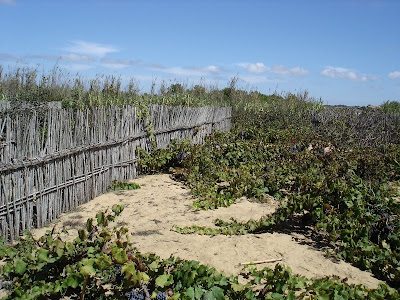

Taking advantage of an important concert in Lisbon to attend, we at Slotovino took an early flight, hired a car with Satnav and managed to get to Colares by way of an unintended but wonderfully serendipidous diversion through the Parque Natural Sintra Cascais. At mid-morning the weather was balmy with a sea mist still clinging to the land. The vegetation was almost Carribean; certainly Atlantic and not at all Mediterranian.
Descending to Colares the cellars of the Adega Regional and across the road, the only slightly less imposing cellars of Visconde de Salreu came instantly into view. In the village was evidence of other historic Colares producers such as Tavares & Rodrigues now looking unused and unloved.
An appointment had been made with Francisco Figueiredo at the Adega Regional where a function was in full swing in the vast and imppressive 'chaix'. Francisco turned out to be immensely well qualified and knowledgeable - both an Agronomist and Oenologist - he had been brought up in Colares and has come to personify the future of the Appellation which as he mentioned was about to celebrate its 100th anniversary - making it the oldest in Portugal.
He succinctly recounted the history from the golden years when what is now a string of seaside resorts was covered in vines and had been known as the Bordeaux of Portugal. Production during the years of the Phylloxera epidemic and up to the 1930s had topped 1 million hectolitres at the Adega Regional alone presumably because the Ramisco vine of Colares were the only ones not to be affecetd due to their being planted in Sand which rendered them immune to the disease. Production is now only 70,000 hectolitres thanks to the fact that the area is now devoted to the developement as a seaside resort.

Asked whether the Ramisco grape was difficult to grow, Francisco said it was this was not the case. It is a late ripening variety and that was why it was buried in sand - to give heat to the grapes at night. He explained that it was actually clay in which the vines were planted and only after 2 or 3 years when they had grown high enough were the stems covered in sand. In fact only half the production of Ramisco in Colares was grown in this way: the other half, away from the beaches was simply grown in clay.
Being young and forward looking, Francisco spoke a lot about the future about which he was not at all pessimistic. While realistic about the situation he spoke of new plantings and research. One of the biggest problems surprisingly enough was the difficulty of making suitable cuttings. Asked if Ramisco was grown anywhere else in Portugal or the wider world he said he had heard of a nursery in the Alentejo selling Ramisco vines so he imagined there may be a few plantings there, but obviously nothing of any consequence.
He and his colleagues decided in the late 1990s after an enforced change of name from D'Areia to Arenae to sell the wine in 50cl bottles of a distinctive shape. Colares is already perhaps the most distinctive wine in the world so they might as well sell it in an idiosyncratic way although this hardly makes life easier for wine merchants or restaurants.
Francisco was charmingly at pains to give equal emphasis to white Colares made from Malvasia although this is hardly as interesting a the red wines from the unique Ramisco grape.
Fransico insitsed on driving up to some Ramisco plots so demonstrate the haunting little vineyards where the harvest had just been carried out. These were the most peculiar plots each enclosed by dry stone walls, the vines looking like derelict cages in a zoo with expired reptiles littering the sandy floor. Some tiny apple trees dotted these plots. Francisco said even these were a unique variety. Apparently there are strong winds especially in August against which the vines had to be protected. Other problems came from rabbits and birds...
Leaving Colares, there remained a singular impression unlike any other in wine country.
With the aid of Satnav we made straight for Lisbon and Garrafeira Nacional in Barreira Alta: a temple to Portuguese wine. There we bought on special offer 2 bottles of Colares Chitas Reserva 1968 with 2 bottles of White Colares Conde Salreu 1967 White, 1 bottle of Colares Chitas 1995 and 1 Colares Fundacao Oriente 2004. We had bought another of the latter in Colares for 2 Euros more! The bill came to E.92.50. Not bad.
With 2 bottles of Arenae kindly given by Francisco (one white, one red) this made 9 bottles to put in our check-in luggage for the journey home. All arrives safely apart from 1 bottle of 1967 white which leaked a bit. Opened a day after arrival, this proved not surprisingly to have been oxydised. We look forward to a Colares evening once the wines have settled and an appropriate list of guests have been invited to a tasting.